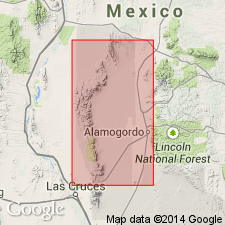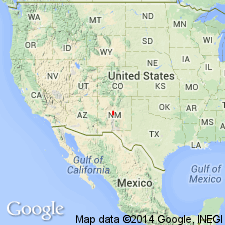
- Usage in publication:
-
- Coyote sandstone
- Modifications:
-
- Original reference
- Dominant lithology:
-
- Sandstone
- Conglomerate
- AAPG geologic province:
-
- Estancia basin
- Orogrande basin
- San Juan basin
Summary:
Pg. 115; Amer. Geol., v. 25, p. 234-237; New Mexico Univ. Bull., v. 2, pt. 3, p. 1-14. Coyote sandstone. Thick sandstone or conglomerate. Separated from overlying Manzano series by a thick series of massive gray siliceous limestones, and from underlying Sandia series by a series of dark conchoidal limestones and shales. Present in Sandia, Manzano, and San Andres Mountains. Age is Pennsylvanian. [Adopted by the USGS as Coyote sandstone member of Madera limestone.]
Named from Coyote Springs, Sandia Mountains, central northern NM.
Source: US geologic names lexicon (USGS Bull. 896, p. 536).

- Usage in publication:
-
- Coyote Sandstone Member†
- Modifications:
-
- Abandoned
- AAPG geologic province:
-
- Estancia basin
- San Juan basin
Summary:
Pg. F7-F8. †Coyote Sandstone Member of Madera Limestone. Abandoned. Conglomerates now included in basal part of Sol se Mete Member (new) of Wild Cow Formation (new) of Madera Group (revised). See Sol se Mete and Wild Cow.
Source: Publication; Changes in stratigraphic nomenclature, 1973 (USGS Bull. 1395-A, p. A12-A13).
For more information, please contact Nancy Stamm, Geologic Names Committee Secretary.
Asterisk (*) indicates published by U.S. Geological Survey authors.
"No current usage" (†) implies that a name has been abandoned or has fallen into disuse. Former usage and, if known, replacement name given in parentheses ( ).
Slash (/) indicates name conflicts with nomenclatural guidelines (CSN, 1933; ACSN, 1961, 1970; NACSN, 1983, 2005, 2021). May be explained within brackets ([ ]).

